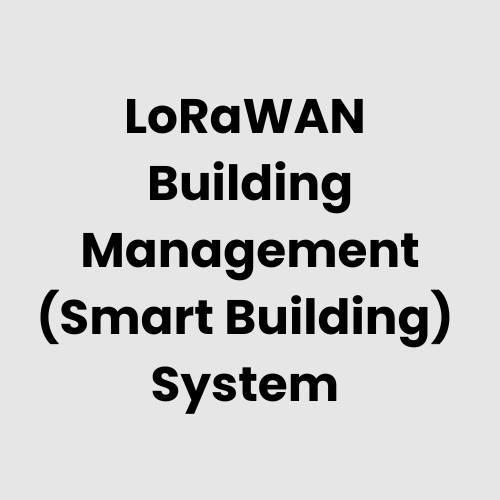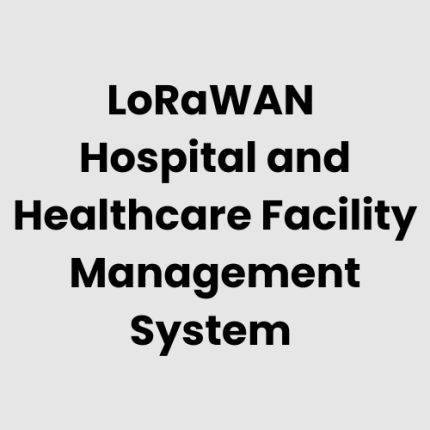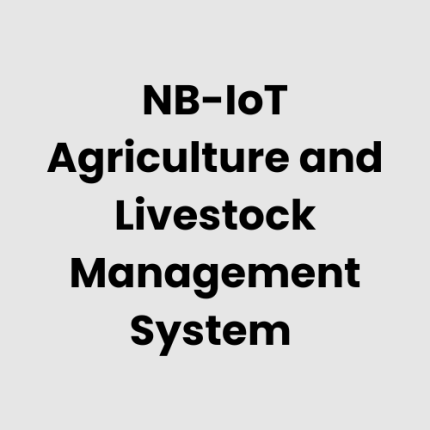Description
Technical Architecture of LoRaWAN Enabled Building Management (Smart Building) System
A LoRaWAN Enabled Building Management system integrates IoT devices across a building’s infrastructure to optimize operations, improve energy efficiency, and enhance occupant comfort. It connects various sensors and devices within the building to a centralized platform for real-time monitoring and control. The key components of the architecture are:
- Sensors and Devices: These are deployed throughout the building to monitor environmental conditions such as temperature, humidity, lighting, air quality, occupancy, and energy consumption.
- Gateways: LoRaWAN gateways collect data from the sensors and transmit it securely over the LoRaWAN network to a cloud platform or local server.
- Centralized Management System: The system aggregates and analyzes the data, offering control, automation, and insights for building management operations, such as HVAC control, lighting, and security.
- Cloud Integration: Data collected by the sensors is uploaded to a cloud-based platform for storage, further analysis, and integration with other enterprise systems.
- Mobile/PC Interfaces: Building managers access real-time data and control the building’s systems remotely through web or mobile applications.
At GAO Tek, we offer end-to-end solutions, including hardware, software, and expert support, for building management systems that integrate LoRaWAN technology.
Hardware of LoRaWAN Enabled Building Management (Smart Building) System
The following hardware components are essential for implementing a LoRaWAN-enabled building management system:
- LoRaWAN Sensors: These sensors monitor parameters such as temperature, humidity, air quality, motion, CO2 levels, and occupancy.
- LoRaWAN Gateways: Gateways are responsible for receiving data from sensors and transmitting it to a cloud or local server via the LoRaWAN network.
- Controllers: These devices manage and control various building systems like HVAC, lighting, and security, based on the data received from the sensors.
- Power Supplies: Energy-efficient power systems are used to ensure the continuous operation of sensors and gateways, with many utilizing solar or low-power technologies.
- Cloud or Local Server: A centralized server or cloud-based system aggregates and processes data for further analysis, reporting, and automation.
GAO Tek provides robust hardware solutions designed to maximize the efficiency and scalability of smart building systems.
Physical Placement Considerations of Hardware in LoRaWAN Enabled Building Management (Smart Building) System
The optimal placement of hardware in a LoRaWAN-enabled building management system is crucial to ensure effective data collection and system performance:
Sensor Placement: Sensors should be placed in areas where they can accurately monitor the specific environmental factors they are designed for, such as:
- Temperature sensors in HVAC systems and different building zones.
- Motion sensors near doors or high-traffic areas.
- Air quality sensors in ventilation ducts or near windows.
Gateway Placement: Gateways should be centrally located to ensure a strong and consistent signal across the building. They must be placed in areas with minimal obstructions to ensure optimal communication with sensors.
Controller Location: Controllers should be placed in mechanical rooms or near system equipment such as HVAC units, lighting panels, and security systems for ease of connectivity and control.
GAO Tek can assist with optimal sensor placement strategies based on building size, layout, and intended system functionality.
Hardware Architecture of LoRaWAN Enabled Building Management (Smart Building) System
The hardware architecture for a LoRaWAN-enabled building management system consists of several layers to ensure seamless operation and integration. It includes:
- Edge Layer: Comprised of LoRaWAN-enabled devices like sensors and actuators that monitor environmental parameters or control building systems.
- Communication Layer: This layer includes LoRaWAN gateways that bridge the communication between the edge devices and the central management platform.
- Data Processing and Management Layer: The centralized platform, either cloud-based or local, processes and analyzes the data, enabling real-time monitoring, reporting, and control of building systems.
- Application Layer: This layer is responsible for user interfaces, where building managers or operators can access the data, configure alerts, and perform system management tasks.
GAO Tek’s hardware solutions are built to seamlessly integrate with each of these layers, ensuring a cohesive building management ecosystem.
Deployment Considerations of LoRaWAN Enabled Building Management (Smart Building) System
Deployment of a LoRaWAN Enabled Building Management system requires careful planning to ensure optimal performance and return on investment. Key deployment considerations include:
- Site Survey: A detailed site survey should be conducted to assess the building’s size, layout, and communication needs. This includes determining optimal gateway placement and sensor density.
- Network Design: The LoRaWAN network must be designed to ensure adequate coverage and low power consumption, with consideration for signal interference or obstructions in the building.
- Integration with Existing Systems: The LoRaWAN-enabled system should be integrated with existing building management systems (BMS), such as HVAC, lighting, and security systems, for unified control.
- Scalability: The system should be scalable to accommodate future expansions or new devices as the building’s management needs evolve.
- Maintenance and Support: Regular maintenance and remote monitoring ensure the system continues to operate smoothly. GAO Tek offers expert support for troubleshooting and updates.
Our team at GAO Tek can guide you through the deployment process, ensuring a seamless and efficient setup.
Relevant Industry Standards and Regulations for LoRaWAN Enabled Building Management (Smart Building) System
- ISO 50001 – Energy Management Systems
- ASHRAE Standards – Building Environmental Performance
- UL 864 – Fire Alarm Systems
- IEC 61508 – Functional Safety of Electrical/Electronic Systems
- IEEE 802.15.4 – Wireless Personal Area Networks
- LoRaWAN Specification – LoRa Alliance
- BREEAM – Sustainable Building Standards
- LEED Certification – Energy and Environmental Design
GAO Tek ensures compliance with all applicable standards and regulations, providing secure, sustainable, and efficient building management systems.
Local Server Version of LoRaWAN Enabled Building Management (Smart Building) System
For buildings that require local data processing or have strict data privacy requirements, a local server version of the LoRaWAN Enabled Building Management system can be deployed. In this setup:
- All data from sensors and gateways is processed and stored on an on-premise server.
- Building managers access the system through a local interface, providing real-time control and reporting.
- Local servers ensure quick response times and complete control over data management.
GAO Tek can supply and configure local server-based systems for customers seeking full autonomy and security over their building management infrastructure.
Cloud Integration and Data Management in LoRaWAN Enabled Building Management (Smart Building) System
For buildings that require remote access, centralized data analysis, and integration with other systems, a cloud-based version of the LoRaWAN Enabled Building Management system is ideal. This setup allows for:
- Real-time data monitoring from anywhere with internet access.
- Aggregated data from various building systems for advanced analytics and reporting.
- Seamless integration with other enterprise systems, including energy management and building automation platforms.
- Remote control of systems, such as HVAC, lighting, and security, for operational efficiency and cost savings.
With GAO Tek’s cloud integration solutions, buildings can be monitored and managed at any time, providing building managers with greater flexibility and control. Our cloud platforms are designed with security and scalability in mind to support buildings of any size.
At GAO Tek, we specialize in developing and deploying LoRaWAN-enabled smart building management systems that drive operational efficiency, sustainability, and comfort. Whether through local or cloud-based solutions, we provide end-to-end service, including system design, hardware supply, integration, and ongoing support. Let us help you optimize your building operations with cutting-edge technology.
GAO Case Studies of LoRaWAN Enabled Building Management (Smart Building) System
USA Case Studies
- New York City, New York
A commercial office building in New York City implemented LoRaWAN technology for its building management system. Sensors were deployed throughout the building to monitor temperature, humidity, and occupancy. This integration improved HVAC efficiency and reduced energy consumption while enhancing overall occupant comfort. The system allows for centralized control and real-time data analysis. - San Francisco, California
In San Francisco, a smart building utilized LoRaWAN sensors for environmental monitoring. By integrating data on air quality, lighting, and energy usage, the building management system optimized energy consumption and improved occupant well-being. The system’s scalability allowed for easy upgrades and future integration with smart city infrastructure. - Chicago, Illinois
A university in Chicago used LoRaWAN technology to create a smart campus, monitoring energy usage, water consumption, and environmental factors. The data collected helped optimize building operations, reduce operational costs, and improve sustainability efforts. The system also provided insights into building performance, aiding in ongoing energy management. - Los Angeles, California
LoRaWAN-enabled sensors were installed in a Los Angeles office complex to monitor lighting, temperature, and security. The system enabled remote management of building operations, reducing energy waste and providing real-time alerts on system failures. The integration of LoRaWAN technology facilitated a seamless and energy-efficient management approach. - Houston, Texas
A large corporate building in Houston integrated LoRaWAN technology to enhance its building automation system. Sensors tracked environmental parameters such as temperature, lighting, and air quality, allowing the building to adapt in real time to occupancy levels. The energy savings were significant, demonstrating the effectiveness of LoRaWAN in smart building management. - Washington D.C.
A federal building in Washington D.C. incorporated LoRaWAN technology for comprehensive building monitoring and control. The system tracked HVAC performance, energy consumption, and air quality, providing valuable insights for optimizing resource usage and maintaining compliance with government regulations. It also allowed for more effective facility management. - Seattle, Washington
In Seattle, LoRaWAN-enabled sensors were installed in a high-rise building for air quality and energy monitoring. The system improved energy efficiency by adjusting lighting and HVAC settings based on real-time occupancy data. The integration also led to improved air quality, contributing to a healthier work environment. - Atlanta, Georgia
LoRaWAN technology was implemented in a smart office building in Atlanta to monitor temperature, humidity, and energy usage. The real-time data enabled the building management system to optimize HVAC operations, improving occupant comfort while reducing energy costs. The solution proved both efficient and scalable. - Dallas, Texa
In Dallas, a healthcare facility adopted LoRaWAN sensors to manage environmental factors like temperature, humidity, and CO2 levels. The system ensured the comfort and safety of patients while optimizing the use of energy resources. The building management team was able to access real-time data remotely, improving operational efficiency. - Denver, Colorado
A mixed-use development in Denver integrated LoRaWAN technology for building management. Sensors monitored lighting, temperature, and occupancy levels, and data was used to optimize energy usage across the building. The smart building system enabled predictive maintenance, reducing downtime and improving operational efficiency. - Miami, Florida
In Miami, LoRaWAN technology was used in a luxury residential building to manage HVAC, lighting, and water usage. The smart system enabled personalized control for residents and building managers alike, contributing to substantial energy savings and enhanced building operations. The system’s scalability allowed it to grow with the building. - Phoenix, Arizona
A retail center in Phoenix used LoRaWAN technology to manage building systems such as lighting, HVAC, and security. Sensors provided real-time data that allowed for efficient energy use and better security management. The building’s smart systems enhanced the shopping experience while reducing operational costs. - Boston, Massachusetts
LoRaWAN sensors were deployed in a historic building in Boston to optimize energy consumption while maintaining the building’s architectural integrity. The system monitored temperature, humidity, and air quality, ensuring that the building remained comfortable while reducing energy waste. The system also enabled predictive maintenance of HVAC systems. - Philadelphia, Pennsylvania
A smart building in Philadelphia utilized LoRaWAN technology to optimize its energy usage. The system monitored temperature, lighting, and air quality, adjusting them in real-time based on occupancy. This helped the building achieve better energy efficiency and provided a comfortable working environment for tenants. - Minneapolis, Minnesota
A mixed-use office complex in Minneapolis implemented LoRaWAN-based smart building technology. Sensors monitored various environmental parameters, enabling the building to reduce energy consumption while improving indoor air quality and occupant comfort. The system’s data analytics helped in predictive maintenance and identifying energy-saving opportunities.
Canada Case Studies
- Toronto, Ontario
In Toronto, a smart office building deployed LoRaWAN technology for energy management. Sensors provided data on lighting, HVAC, and occupancy, allowing the building management system to adjust environmental factors in real-time. The integration of LoRaWAN led to significant reductions in energy consumption while enhancing occupant comfort. - Vancouver, British Columbia
LoRaWAN sensors were installed in a residential complex in Vancouver to monitor temperature, humidity, and air quality. The building management system allowed for precise control over environmental factors, ensuring energy efficiency and improved indoor comfort. The system provided remote access for building managers and was easily scalable for future upgrades.
Navigation Menu for LoRaWAN
- LoRaWAN Gateways
- LoRaWAN End Devices
- LoRaWAN – Cloud, Server, PC & Mobile Systems
- LoRaWAN Accessories
- LoRaWAN Resources
Navigation Menu for IoT
- LORAWAN
- ZIGBEE
- Wi-Fi HaLow
- Z-WAVE
- BLE & RFID
- NB-IOT
- CELLULAR IOT
- GPS IOT
- IOT SENSORS
- EDGE COMPUTING
- IOT SYSTEMS
Our products are in stock and can be shipped anywhere in the continental U.S. or Canada from our local warehouse. For any further information, please fill out this form or email us.
We are actively looking for partners who are like us located in the U.S. and Canada. For more information on partnering with GAO, please visit Partner with GAO Tek Inc. It lists various ways to partner with GAO, such as OEM Partnerships, Technology Integration, Distribution and Reselling Opportunities, Presenting at the Leading Event Tek Summit, Joint R&D Projects, Training and Consulting Services, Industry-Specific Collaborations, Research and Academic Partnerships.



